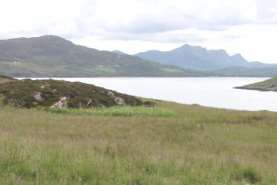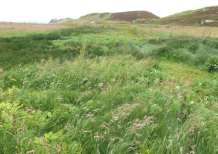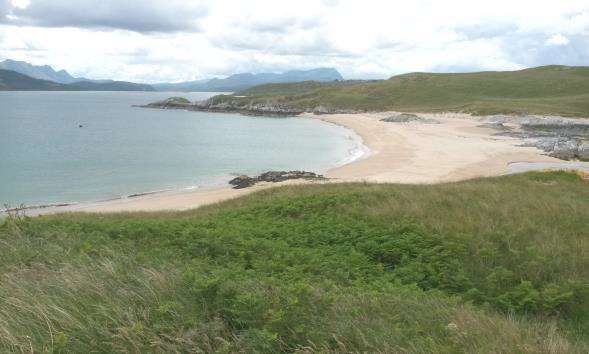Text: Ian M Evans

In the mouth of the Kyle of Tongue (NC6063) lies the small archipelago known as the Rabbit Islands. I have long wanted to visit them, and finally achieved that ambition on 13 July 2016, in the company of four other members of the HBRG, Stephen Moran, Gwen Richards, Gordon Rothero and Ro Scott. We hired a boat out of Skerray harbour, piloted by local man Andrew Maclean, left at 0900 hrs, and had an interesting journey of an hour or so across some 5km of open sea to reach the islands. We re-embarked at 1400 hrs for an uneventful passage back to Skerray.
The main purpose of our visit was to gather botanical records for an ongoing survey of selected 1km squares in eastern parts of West Sutherland, a contribution to the next BSBI Atlas. Stephen joined us to sample the insect life, Gordon listed the bryophytes and all of us recorded anything else that came to our notice.

Background information. The two southern islands, linked by a tidal sand spit, are also known as Eilean nan Gaill. The rocky one in the north-east is Sgeir an Oir. The western one is also connected to the mainland at Ard Skinid, by a sand spit, An Oitir, exposed at very low tides, across which it is said you may (briskly?) walk dryshod,
and sheep were driven to the islands in times past.
The total area of the islands is rather less than a square kilometre, and their highest points are all about 45m above sea level. They lie across a geological unconformity, with Moine rocks in the west, and Lewisian in the east, but much of the southern half of the western island, and the south-western corner of the eastern one,
are covered by calcareous sand.

The islands appear never to have been inhabited in historic times, although there is a local story about a ‘renegade’ who lived there for a while. One possible reason is a scarcity of drinking water. However, they are still grazed by a small number of sheep brought over from Melness. The rabbits, after which they were named, apparently succumbed to myxomatosis (Allan Mackay, pers.comm.).
Few naturalists have visited the islands. The most detailed account is of a visit made by R.E.C. Ferreira, in late August 1989, as part of his comprehensive ‘Vegetation Survey of North-West Sutherland’ (SNH, 1995). He quotes a report on an earlier visit, on 24 September 1973, by J.Grant Roger of NCC, in the course of his ‘Botanical Survey of NW Sutherland Sites’, which I have not yet located. There are few faunal records from the islands, although Valerie Wilson of SNH has mentioned short-eared owls, presumably preying on field voles,
and some other bird interest. The islands have no specific conservation designation, but are part of the Kyle of Tongue National Scenic Area.
Our visit lasted rather less than four hours and to make best use of the time we split into two botanical survey parties, with Gwen and I taking the western island, Ro and Gordon the eastern one. Meanwhile, Stephen deployed his bug-vac, and other collecting techniques, on parts of both readily accessible from the central sand spit. The Highland Naturalist – Number 13 – April 2017.
Vegetation
The overall purpose of Chris Ferreira’s survey was to locate and describe the vegetation of areas of botanical interest out-with existing designated sites. In his view, the Rabbit Islands carried “one of very few dunes on the Sutherland coast currently free from grazing throughout the year” and he added, “the resulting superb condition and wide range of species on the ungrazed Ammophila-fixed dune on the inner island [is] the most important single feature”, although “the strand flora…and the fens and wet grasslands on both dunes [are] also important” (Ferreira 1995, site 3.3.6).

He gave a detailed description of the plant communities present, and we found nearly all the species
he mentioned. This was reassuring and, to our eyes, the dune and other vegetation is still in as good
a condition as it was back in 1989. The only species we did not find are: two of the shoreline oraches
Atriplex glabriuscula and A. laciniata, which are difficult to identify; “scattered plants of Orchis
mascula” [early purple-orchid], for which we may have been a bit late; Saxifraga aizoides [yellow
saxifrage] and Sagina nodosa [knotted pearlwort] in a small area of fen “at the northern end of the
eastern beach”; “one patch of Salix aurita” [eared willow], and Chenopodium album [fat hen] in a
dried out pool on the eastern island probably used by gulls.

Flowering plants and ferns. We almost certainly covered more of the two islands than Chris Ferreira was able to do in the time available to him. However, Gwen and I spent most of our time on the calcareous dune grassland and associated rocky gullies, outcrops and crags at the southern end of the western island. This is quite challenging ground to botanise, given a deeply indented coastline and steep cliffs. We made a brief sortie onto the summit plateau, where we found some unexpected boggy ground, but did not get into the northern third. Ro and Gordon worked round the edges of the highly fissured and even rockier eastern island and reached its northern end. They commented on the dense nature of the vegetation in parts of this island, especially the grassland.

The total count was a very respectable 171 species, with 129 from the western island and 139 from the eastern. There were interesting differences between the flora of the two, with 26 species recorded only from the western, and 39 from the eastern.
Species of particular interest on the western island included: alpine bistort Persicaria vivipara on the
calcareous dunes, and small adder’s-tongue fern Ophioglossum azoricum and reflexed saltmarsh grass
Puccinellia distans ssp. borealis in a rocky gulley at the southern end. The boggy ground on the plateau had a patch of yellow flag Iris pseudacorus and a variety of other marshland species. The eastern island yielded more typically heathland plants, and the only examples seen of three trees, downy birch Betula pubescens, rowan Sorbus aucuparia and aspen Populus tremula, the last on the walls of a geo on its eastern side. Other species not noted elsewhere included: black bog-rush Schoenus nigricans, frog orchid Coeloglossum viride in dune grassland, heath fragrant orchid Gymnadenia borealis in short maritime heath, the hybrid between heath spotted and northern marsh orchids Dactylorhiza x formosa and bluebell Hyacinthoides non-scripta.
Bryophytes (Gordon Rothero). The Rabbit Islands are relatively small, relatively exposed and obviously maritime and all these factors affect the bryophyte flora; some species can tolerate these conditions and some flourish, but others find the exposure and particularly the salt just too much. This visit was restricted to the eastern island, where some 52 bryophyte taxa were recorded, most of them being tolerant generalist species that are common all over Scotland. A longer visit which included the western island would certainly increase this total, but the flora will always be fairly limited.

The exposure and the lack of sheltered niches means that the oceanic bryoflora is very limited, but the broken sea cliffs do have some stands of Isothecium myosuroides var. brachythecioides, Scapania gracilis and Saccogyna viticulosa, and Ulota phyllantha occurs on coastal rocks. The area of blown sand between the two islands offers the only calcareous habitat and the typical shell sand species Syntrichia ruraliformis and Homalothecium lutescens occur here and, where there is some seepage, calcium-encrusted cushions of Gymnostomum aeruginosum. Associated coastal rocks have an assemblage that is common along the Sutherland north coast with Grimmia pulvinata, Ulota phyllantha, Homalothecium sericeum, Hypnum cupressiforme var. resupinatum, Trichostomum crispulum, Bryum capillare, Bryum alpinum, Orthotrichum rupestre and the ubiquitous Schistidium maritimum.
Away from the coastal strip, the ground vegetation is coarse and only robust bryophytes like Rhytidiadelphus triquetrus, Hylocomium splendens, Pleurozium schreberi and Pseudoscleropodium purum are at all common. Flushed grassland has some Dicranum bonjeanii and more open flushes have Campylium stellatum and, in one place, the much less common liverwort Solenostoma subellipticum, along with the only Sphagnum species that were seen, S. denticulatum and S. subnitens.
Fungi
Only two records were made of this group. The conspicuous gall of the rust Puccinia urticata was noted on common nettle on the eastern island and a hawkweed on a crag on the western island was afflicted by a powdery mildew, which Bruce Ing informed us was the only species found on hawkweeds, Golovinomyces cichoracearum


Vertebrates
Both common and grey seals were hauled up on the central sand-spit before we landed, when they left, curiously, in opposite directions. The only other signs of mammals, other than sheep, were the burrows and droppings of field voles in dune grassland at the southern end of the western island, and otter spraints and footprints on the eastern. Birds were also thin on the ground. Meadow pipit and wren were noted on the western island and Ro had fulmar, cormorant, shag, greylag goose, eider, fulmar, oystercatcher and herring gull on the eastern, where she also picked up a wing of a storm petrel. Storm petrels have been ringed on the islands in the past (Tony
Mainwood, pers.comm.).
Insects (Stephen Moran).
The relatively short time available on the islands resulted in a rather moderate list of insects. The first to appear, on a rocky outcrop near the landing point, was the large silverfish Petrobius maritimus (care needs to be taken with these as there are two very similar species on our coasts). Of the ten beetle species observed, it is worth flagging up Sitona lineellus, a broad-nosed weevil often seen in dry sandy places like the dunes here. The five flies listed included the handsome blowfly Cynomya mortuorum and the distinctive picture-winged fly Palloptera
quinquemaculata.
Of the 20 bug species recorded, nothing was of particular note and, as I have often found on small island trips, some of the ‘staples’ did not put in an appearance. Pondskaters on a brackish pool in between the islands had to be left at ‘Gerris sp.’, as there were no adults present. Only eight butterflies and moths were noted, common blue and dark-green fritillary being the only butterflies. Dark green fritillaries were also recorded in some numbers by Paul Castle during a brief visit on 22nd July 2008, together with meadow browns, which we did not see (Paul Castle, pers.comm.). Six-spot burnet moths were much in evidence. The tortricid Pammene aurana was seen on hogweed and this
may be a useful north-western extension of its known range.

The islands did indeed save the best until last. At the very moment the returning boat chugged into the bay to collect us, I found a tiny lacewing in the short turf of the dunes on the eastern island. I
suspected, and later confirmed, that this was Psectra diptera, a member of the brown lacewings (Hemerobiidae) which lacks hindwings in most situations. I have been hoping to encounter this
species ever since I became interested in the group 36 years ago, and so it seemed somewhat odd to find it for the first time on such a small offshore island. Scottish records are very few and far
between, but I know how to look for it now. In all, around fifty insect species were noted and the records will be with NBN by the time this issue is printed.
Invertebrates other than insects. Stephen’s collecting was the most productive source of records from these groups, supplemented by casual observations from both islands.
Two woodlice were noted, the ubiquitous Oniscus asellus and Philoscia muscorum, both on the western island. Mites were represented by Aceria thomasi, which causes hairy rosette galls on thyme, on both islands. The common harvestman Mitopus morio was seen on the eastern island. There were a few records of spiders. The orb-web spinner Araneus diadematus occurred on both islands, and Stephen had the ant mimic Micaria pulicaria, the crab spider Xysticus cristatus and the wolf spider Pardosa nigriceps, all on the eastern island and another wolf spider, P. pullata, on the western. All the spiders are widespread in the Highland area, with the exception of M. pulicaria, for
which records are sparse.
Five species of molluscs were recorded, our identifications being kindly confirmed by Dr Adrian Sumner of the Conchological Society. The least moss snail Cochlicopa lubricella, heath snail Helicella itala and common chrysalis snail Lauria cylindracea occurred on both islands. The copse snail Arianta arbustorum was found in the plateau boggy area on the western island. There remains my record of the dark-lipped snail Cepaea nemoralis from dune grassland just above the beach on the western island (NC60206285). My field note is quite unambiguous, but I had forgotten how uncommon this species is on the north coast and did not retain a specimen, so this record requires
confirmation.
In conclusion, I should like to thank all those who have contributed to this account of our visit, in particular the four other participants, and other naturalists who have shared recollections of their often brief visits. Our four hours ashore yielded records of some 300 species, including several that are noteworthy in a Highland or Scottish context. Even the lists of plants are, inevitably, incomplete, but they do appear to add substantially to what has previously been recorded. We were pleased to be able to confirm the continuing outstanding state of the vegetation on the islands, the sun shone all day and it was a most enjoyable expedition.






